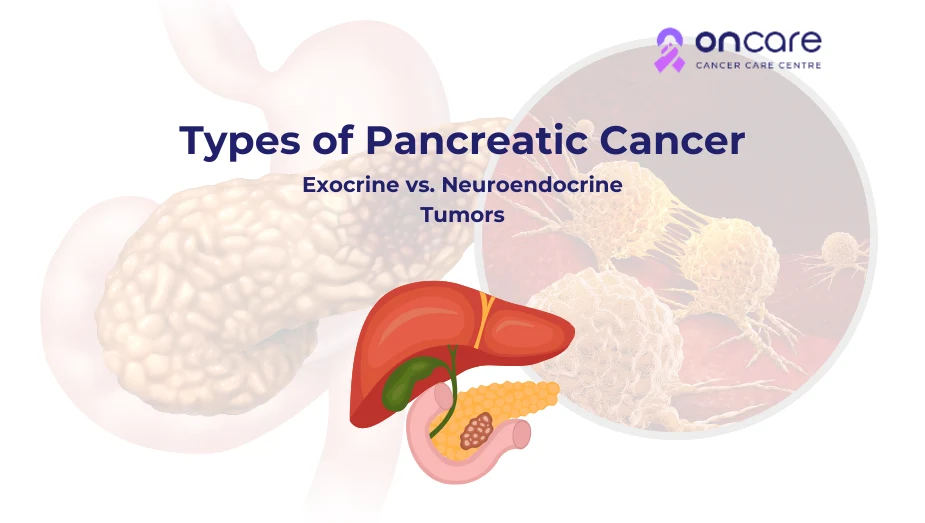Table of Contents
Types of Pancreatic Cancer: Exocrine vs. Neuroendocrine Tumors

Pancreatic cancer is one of the aggressive types of cancer usually diagnosed in the advanced stages. But here’s the catch: do you know all pancreatic cancers are not the same? There are two types of pancreatic cancer: exocrine tumors and neuroendocrine tumors (NETs), and both appear differently from one another!
In this article, understanding the difference between these two types can help in choosing the right treatment approach and improving treatment outcomes.
Exocrine pancreatic cancer
Approximately 90% of pancreatic cancers are classified under these exocrine tumors. These types of tumors usually start in the exocrine cells that produce enzymes, which help to digest food. The most common type of pancreatic cancer is adenocarcinoma, which usually begins in the cells that line the organs.
Common types of exocrine tumor
The most common types of exocrine tumors may include:
Pancreatic Ductal Adenocarcinoma
This is the most common type of pancreatic cancer. This type of cancer usually starts in the ducts. It carries enzymes out of the pancreas, and this type of cancer spreads quickly.
Adenosquamous carcinoma
This is the rarest, most aggressive type of cancer with features of both glandular and squamous cells. This cancer is less common, and it grows and spreads quickly.
Acinar Cell Carcinoma
This is a rare type of cancer that usually develops in the acinar cells, which are responsible for secreting enzymes. All these types of cancers might account for any unusual symptoms like any unusual skin rashes and steatorrhea, which is fat in the stools (poops).
Colloid Carcinoma
This is a rare type of cancer with better prognosis due to slow progression in the pancreas. It usually accounts for 1-3% of the malignant neoplasms of the exocrine pancreas.
Neuroendocrine Tumors
Pancreatic neuroendocrine tumors (P-NETs) account for about 7% of pancreatic cancers. These tumors usually begin in the hormone producing cells of the pancreas. According to many studies, these P-NETs are the third most common type of Neuroendocrine Tumors (NETs).
Types of Neuroendocrine Tumors
In most cases, the researchers classify these NETs based on whether they release hormones.
- Functional NETs : These types of tumors release hormones that can cause hormone-related symptoms in most patients. These functional NETs produce hormones like insulin and gastrin, which often lead to noticeable symptoms in the early stages, like blood sugar and ulcers.
- Non-functional NETS: These types of tumors don’t release hormones. It can still cause symptoms if it impacts the pancreas. While it won’t produce any active hormones, it often goes unnoticed until it grows large.
Differences between Exocrine and Neuroendocrine tumors
Here are the major differences between exocrine and neuroendocrine tumors in pancreas.
Features | Exocrine tumors | Neuroendocrine tumors |
|---|---|---|
Frequency | 93% | 3% |
Origin | Exocrine cells | Hormone producing cells |
Common subtype | Pancreatic Ductal Adenocarcinoma | Insulinomas |
Growth rate | Aggressive and fast-growing | Slow - growing |
Diagnosis time | Late diagnosis | Late diagnosis |
Treatment options | Surgery, chemotherapy, radiation therapy | Surgery, chemotherapy, hormone therapy, targeted therapy |
How are both these cancers diagnosed?
It’s quite difficult to diagnose pancreatic cancer in the early stages. In most cases, healthcare providers can’t feel any abnormalities in the pancreas during the routine exams and it’s difficult to see these tumors on these routine imaging tests.
If your medical team suspects any types of pancreatic cancer, they will recommend a combination of pancreatic function test, which may include:
Imaging tests:
- CT scan (computed tomography)
- MRI (Magnetic resonance imaging)
- PET (Positron emission tomography)
- Endoscopic ultrasound (EUS)
Blood tests:
Performing blood tests can detect any types of tumor markers. A tumor marker is a substance that might indicate the presence of cancer.
For pancreatic cancer, the presence of high levels of carbohydrate antigen (CA) 19-9. A type of protein released by the pancreatic cancer cells often indicates a tumor.
Biopsy:
Pancreatic cancer is diagnosed through various biopsies the most common types are:
- Fine needle aspiration biopsy
- Core needle biopsy
- Endoscopic ultrasound biopsy
Hormonal level tests:
For diagnosing pancreatic neuroendocrine tumors, hormonal level tests are performed in suspected patients. There are some specific hormones, such as insulin, gastrin, glucagon, and others that are generally used in blood tests.
Why is understanding these cancers significant?
According to many studies, different treatment plans and survival rates differ significantly depending on the type and stage of the pancreatic cancer.
- Exocrine tumors requires an aggressive treatments that carry more serious and complex healing journey
- Neuroendocrine tumors, mainly the functional ones are considered as manageable diseases with proper care and treatment
Recognising the type of cancer helps you and the medical team to personalise your treatments the best possible treatment outcomes!
Consult Today
People often assume that pancreatic cancer is a single disease. It appears as two different types of diseases, like exocrine and neuroendocrine tumors. Each cancer has its own specific causes, symptoms, treatment options, and outcomes. Understanding the distinction might empower patients and families; it helps to guide this challenging diagnosis with more clarity and confidence.
At Oncare, we offer premium-quality cancer treatments including advanced cancer surgeries at affordable price ranges with an experienced cancer specialist consultation.
If you or any loved ones of yours are diagnosed with cancer, then visit Oncare Cancer Center and book an appointment with our cancer specialist today. Get an estimated cost of your cancer treatments today!
Frequently Asked Questions
Here are some of the symptoms of pancreatic cancer:
- Jaundice
- Dark urine
- Light- colored stool (poop)
- Upper abdominal pain
- Middle back pain
- Fatigue
- Itchy skin
- Nausea and vomiting
- Gas or bloating
- Lack of appetite
- Blood clots
- Weight loss
- New- onset diabetes
Common pancreatic cancer risk factor may include:
- Smoking cigarettes
- Obesity
- Type 2 diabetes
- Chronic pancreatitis
- Hereditary syndromes with changes
- Hereditary pancreatitis due to gene changes
- Exposure to certain chemicals like pesticides and petrochemicals
There is nothing you can do to prevent pancreatic cancer. But there are things you can do to prevent and lower the risk of developing it.
- Stop smoking cigarettes
- Limit your alcohol consumption
- Eat a lot of fruits, vegetables and whole grains
- Reduce the intake of red meat, processed meat and processed foods
- Limit the exposure of chemical substance like asbestos, pesticides and petrochemicals
- Maintain healthy weight for you
Here are some of the symptoms of pancreatic cancer:
- Abdominal pain
- Extreme fatigue
- Sudden weight loss
- Jaundice
- Fluid buildup
- Swelling in the abdomen

